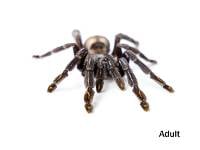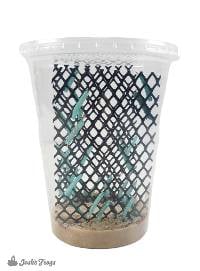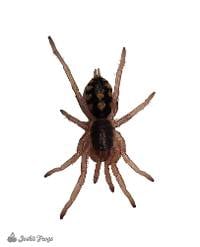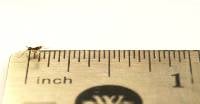Josh's Frogs
Gold Banded Sunburst Dwarf Tarantula - Neischnocolus sp. Panama (Captive Bred)
Gold Banded Sunburst Dwarf Tarantula - Neischnocolus sp. Panama (Captive Bred)
$49.99 0.0 out of 5 stars
(0)
0.0 out of 5 stars
(0)About This Product
SPECIAL NOTE: USPS forbids shipping venomous spiders or scorpions in the mail.
Because of this, we ship these animals FedEx priority overnight for a flat fee of $39.99.
Characteristics:
- This species does not have a particularly expansive history in the hobby, though it is gaining popularity. Thankfully climate data from its natural habitats has made it possible for keepers to help these spiders thrive in captivity.
- A terrestrial new world dwarf species, these slow/medium growers do not require a particularly large environment and would make a good candidate for a desk pet.
- As adults, this species boasts beautiful vibrant coloration on its abdomen. These are real lookers and make a great addition to any collection, and are a must have for dwarf tarantula enthusiasts!
Neischnocolus sp. panama (Gold Banded Sunburst Dwarf) was previously called Ami sp. Panama, however after further study it was found to belong to the pre-existing genus "Neischnocolus" which was first described by Petrunkevitch in 1925. "Ami" is now considered a junior synonym of Neischnocolus, which is a genus native to Central and South America.
Enclosure size: They remain obligate burrowers throughout much of their lives, as babies a dram vial or pill bottle large enough to give them at least 1"-1.5" of substrate to burrow in is appropriate for quite some time. As the little ones grow into adults they will need closer to 6” of substrate. For floor space 3-4x the spider’s diagonal leg span for both length and width is appropriate; just make sure that the space above the substrate does not exceed 2x the spider’s diagonal leg span to prevent injury from a fall. Because of the humidity these critters need, they are great candidates for a live planted tank with some hardy plants that can take a little digging. In fact, a lot of people recommend this to improve air quality within the enclosure.
Temperatures: A comfortable range for them is 76-82 degrees, temperatures consistently 65 degrees or below or above 90 degrees should be avoided for the longevity of the spider.
Humidity: 70%-80%, This can be achieved by keeping the substrate uniformly damp. This can be accomplished by giving the substrate a mist 2-3 times a week, or more frequently if you notice that the top layer of substrate is drying out quicker. This may especially be necessary for those who live in particularly dry climates, or during the winter. An appropriately sized water dish can be offered even for slings (tattoo ink cups or shallow water bottle caps work wonderful for sling enclosures). It is important not to over-saturate the substrate as that can lead to unfavorable molting conditions.
Size: Young N. sp. Panama sold Josh’s Frogs are approximately 1/8” diagonal leg span. This species' size tops out at about 2.5"-3" with males trending a bit smaller.
Age: Specimens from Josh's Frogs are at least 2 months at time of sale. Females of this species live around 10-12 years, while males live a much shorter time, around 3-5 years.
Feeding: At time of sale specimens are eating D. melanogaster fruit flies. As they age they can size up to hydei fruit flies and then crickets when larger prey becomes necessary. Slings are also more than happy to scavenge feed on pre-killed prey. Freshly perished pinhead crickets (or the jumper leg pulled off a larger cricket), freshly deceased mealworms or wax worms are all good food choices, but should be removed after 24 hours to prevent mold. Feeding should consist of one to three feeder bugs no bigger than the spider's carapace every 4-7 days. Do not offer food less than 7 days after your spider last molted as this can cause injury to the spider.
Sexing: Due to age, N. sp. Panama sold by Josh's Frogs are unsexed. As they approach maturity, specimens may be sexed using a molt, due to the small nature of this spider molt sexing may require a magnifying glass. Females will have spermatheca and a uterus externus between the top set of book lungs that will catch and "flap" if a pin is run down the inside of the abdomen. Males will have a much more plain slit that does not budge with attempts to manipulate it.
Coloration/Patterning: Babies are a fairly uniform fawn/brown, while adults have a gray carapace and legs that sometimes look a little blue depending on where they are in their molt phase. Their legs also have yellow banding and their abdomen is a rich gold coloration with black patterning.
Social behavior: N. sp. Panama are not social creatures, any attempts to cohabitate will likely result in cannibalism.
Breeding: Spiders for breeding purposes should remain supervised when together and should only be attempted well fed. Mature males can be put in the enclosure of a mature female for courtship/mating. Remove male promptly after insertion is observed, or immediately if female is aggressive rather than receptive. This is best done around a month after the female molts, as a freshly molted female is less likely to molt out of a pairing.
Links of Interest:
- Arachnoboards: a community of spider enthusiasts that will be able to or have already answered almost any question you can think of with regards to tarantulas.
Still not sure if a Gold Banded Sunburst Dwarf Tarantula from Josh's Frogs is the right pet bug for you? Read the reviews below and see what other customers are saying!
Shipping
After placing an order containing a live animal, you will receive a scheduling email containing our JotForm scheduling link to schedule your new pet's delivery date.
With this scheduling link, you will be able to schedule your order's delivery up to 30 days in advance. You will be able to choose a date of delivery for Tuesday-Saturday (Saturday arrival depends on the carrier's service availability) with the estimated time of arrival generally being 12pm, or 4:30pm for more rural areas. Overnight lows must be above 40°F to ship directly to you (or above 30°F for FedEx Ship Center pickups) as well as below 90°F by estimated time of arrival.
If you require further assistance, or prefer to talk to one of our Customer Service agents, please feel free to reach out to our [email protected] email or our phone line 1-800-691-8178.
Other Customers Also Bought
Customer Reviews
0.0 out of 5 stars
Review data
5 star reviews
- 0%
4 star reviews
- 0%
3 star reviews
- 0%
2 star reviews
- 0%
1 star reviews
- 0%





